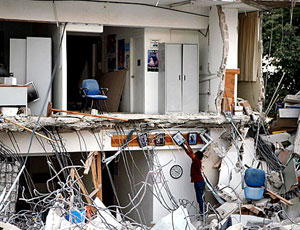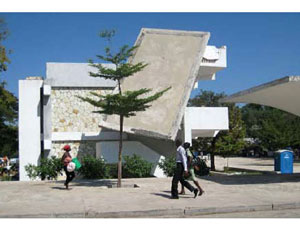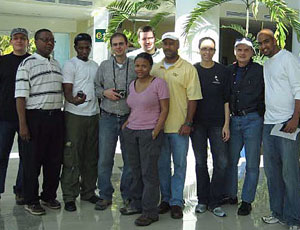Structural engineers on reconnaissance missions in quake-ravaged Haiti observing the salvaging of compromised building materials are extremely concerned about premature rebuilding. The work, getting under way, is perpetuating the very poor construction practices that caused hundreds of thousands of collapses and more than 170,000 deaths in the magnitude-7 earthquake that struck on Jan. 12 with an epicenter 25 kilometers from Port-au-Prince.



“We observed several instances of people” salvaging reinforcing-steel bars out of broken concrete elements from the rubble of pancaked buildings, says Andre Filiatrault, a University at Buffalo civil engineering professor and director of the Multidisciplinary Center for Earthquake Engineering Research (MCEER), also at UB.
Filiatrault was in Haiti to perform building damage assessments. “They would then straighten the bars and resell them for new construction,” which is improper because the bars would have experienced “large inelastic deformations and would be very brittle after restraightening,” he adds.
Filiatrault says he also saw Haitians making cosmetic repairs of structural damage. These kinds of activities need to be “prohibited by the government” to improve the construction quality in Haiti, he stresses. “It is essential to discuss the establishment and enforcement of Haitian building construction standards with local agencies,” he says.
Filiatrault made his observations after returning from a Jan. 21-25 trip as leader of a team of 10 French-speaking structural engineers. The trip was organized by MCEER and the Appropriate Infrastructure Development Group, which is a U.S. organization that aids developing countries. In addition to Filiatrault, the team included Dan Gregory, Green Energy Corp.; Eddy Germain, N.J. Dept.of Transportation; Vladimir Charles, Second Floor Studios; Wassim Ghannoun, University of Texas; Gabrielle Rigaud, Tufts University; Scott DeHollander, MRB Group; Reginald DesRoches, Georgia Institute of Technology; Caroline Zennie, Parsons Corp.; and Jean-Philippe Simon, U.S. Dept. of Defense.
Soon after MCEER-AIDG investigators arrived in Haiti, the United Nations chartered the group as its interim lead coordinating team for organizing and initiating building assessments. Ironically, the U.N. mission—one of the newer buildings in Haiti—collapsed during the quake.
Haiti occupies roughly the western third of the island of Hispaniola in the Caribbean and shares the island with the Dominican Republic. The temblor was a consequence of a rupture along the Enriquillo Plantain Garden Fault. The rupture, at a shallow depth of 13 km, occurred after 240 years of inactivity along the fault.
While in Haiti for reconnaissance from Jan. 14-20, Eduardo Fierro, president of BFP Engineers Inc., Berkeley, Calif., also saw worrisome reconstruction, which included masons reconstructing collapsed walls using the exact technology that caused them to fail. “The international aid and engineering communities need to help educate Haitians regarding the earthquake hazards and provide basic, easy-to-understand guidance on how to rebuild in a more quake-resilient fashion,” says Fierro, who represented the Pacific Earthquake Engineering Research Center in Berkeley, Calif.
Fierro suggests international groups provide immediate assistance to the Haitian government to develop and adopt a provisional building code with seismic provisions. These recommendations might be based on existing codes in the Dominican Republic or Peru, he says. His report, including photos, is available online.
The engineer also suggests organizing seminars on seismic design for Haitian architecture, engineering and construction professionals. He also advises translating into Creole or French a Peruvian booklet on confined masonry construction and making it available free of charge. In addition to his other more short-term ideas for the use of aid money, Fierro suggests providing scholarships to existing Haitian students studying architecture and engineering to go abroad to finish their studies. Haitian schools are not currently able to function and do not have an appropriate seismic curriculum, he says.
The MCEER team, called the Interim Emergency Engineering Support Unit, assessed 115 of the buildings still standing in Port-au-Prince. They used the ATC-20 rapid evaluation safety-assessment procedures developed by the Applied Technology Council. The team created an e-mail account to receive and prioritize building evaluation requests. The team’s report and other Haiti information is online.
The engineers covered 20 to 25 buildings a day. On 64 buildings, the team placed a green tag, which indicates a building appears to be safe for lawful occupancy. On 25 buildings, the team placed a yellow tag, which indicates a building owner may allow limited entry and restricted use. he team placed a red tag, which indicates entry is unsafe and no entry is allowed unless controlled by the jurisdiction, on 26 buildings. Though the breakdown by building type is not available, the team inspected at least 33 hospitals and medical facilities, 33 U.N. office buildings and residences, eight private dwellings, seven schools and colleges, six warehouses, five commercial buildings, three government buildings, two orphanages and six other types of buildings.
The MCEER-AIDG team inspected large warehouses for the U.N.’s World Food Program (WFP), which wanted to know if its staff could access the several thousand tons of food stored inside. The warehouses have various structural systems, including unreinforced masonry frames, concrete frames and steel structures. The roofs are supported by steel-truss systems. “In general, these structures performed well, although some should not be used at all,” says Filiatrault.
The engineer describes the assessment work as “pretty intense. The environment is rough, both physically and psychologically.”
The team was concerned for the safety of the quake survivers who, still hesitant to enter buildings for fear of secondary collapses and aftershock damage, were camping, walking and more under and around very unstable buildings. “We made the decision to send two members of our team to rope off the multitudes of hazard areas in the yards of a very large Catholic school to prevent further injuries or death in the event of more aftershocks,” says Filiatrault. “It is not our responsibility to do this kind of work, but we felt that it had to be done because these people have not been helped at all yet.”
Another MCEER/AIDG team will be inspecting buildings until Feb. 5.



Post a comment to this article
Report Abusive Comment